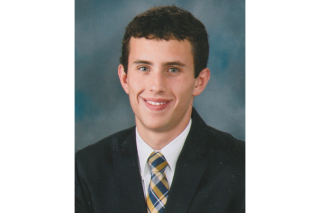News & Events
ALERT Newsletter
Kurt Jaisle Selected as Finalist in IEEE AP-S Student Paper Competition May 30, 2017
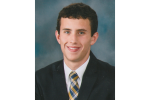
May 30, 2017
ALERT student researcher and Northeastern University Scholar, Kurt Jaisle has been selected as a finalist in the 2017 IEEE Antennas and Propagation Symposium’s (AP-S) Student Paper Competition for his paper, “Ray-Based Reconstruction Algorithm for Multi-Monostatic Radar in Imaging Systems.”
Being selected as a finalist is quite an accomplishment, as each paper submitted to the IEEE AP-S Student Paper Competition undergoes three independent reviews from experts in each student’s field of study. Jaisle’s submission was selected out of 159 papers, most of which were submitted by doctoral students. Kurt is a third year undergraduate student majoring in Electrical and Computer Engineering and conducts ALERT research with Professor Carey Rappaport on the R3 Research Thrust (Bulk Sensors & Sensor Systems).
Jaisle believes that the topic of his paper is relevant to aviation security and the Homeland Security Enterprise: “Today’s airport security scanners use very computationally demanding algorithms to process sensor data into an image of a passenger. As a result, these scanners require expensive, high-performance computers to complete the algorithms in a reasonable amount of time. Yet even with these powerful machines, it can still take several seconds for a scan to be processed.” In his paper, Jaisle proposes a new algorithm that would result in significantly faster processing times resulting in shorter lines for passengers at airport security checkpoints, and a reduction in the cost of the computer hardware used in scanners, potentially making the technology more accessible for broader security applications.
Under the guidance of Professor Rappaport, Jaisle began coding the algorithm in Fall 2015. Over the course of a year, he managed to bring the algorithm from a rudimentary 2D simulation to a functional 3D simulation worthy of publication. Reflecting on his experience conducting research with Professor Rappaport, Jaisle states, “Aside from a great deal of technical knowledge, I think the most important thing I have learned from Professor Rappaport is to not leave an endeavor half-finished. Even when I was stuck on a technical challenge for weeks at a time, he would remind me that progress in research is non-linear and that it was worth seeing it through so that I could eventually share my work with the broader community.”
Jaisle’s interest in engineering was sparked during middle school, when he became involved in FIRST Robotics, a program that aims to develop young STEM leaders through robotics competitions. As time passed, he became interested in the electrical side of engineering and decided to pursue this field of study at Northeastern University. After graduation, Jaisle plans to pursue a Master’s Degree in the context of analog electronics, and is hoping that his upper level Electrical Engineering courses, co-op opportunities, and research experiences will help him choose a specific topic of study.
Jaisle will present on his selected paper at the IEEE AP-S Symposium in San Diego, California in July. Following the presentations, the Student Paper Competition Committee Chair will announce the first, second, and third place winners at the IEEE A-PS Symposium’s Annual Awards Ceremony.
ADSA16: Bringing Transportation Security Stakeholders Together May 30, 2017

The Sixteenth Advanced Development for Security Applications (ADSA16) Workshop was held on May 2-3, 2017 at Northeastern University in Boston with 160 participants in attendance. The theme for the workshop was “Addressing the Requirements for Different Stakeholders in Transportation Security,” which explored the stakeholder perspectives of the Transportation Security Administration (TSA), airlines, vendors, passengers, academia, and national labs.
Some of the topics discussed at ADSA16 were methods and technologies to optimize airport security checkpoints; emerging technologies; explosives trace detection; deep learning; and techniques and strategies for securing soft targets (malls, arenas, outdoor events).
ADSA16 was unique from previous workshops, because it included the involvement of airline representatives from Alaska Airlines and Jet Blue, who discussed the importance of forming partnerships with aviation security stakeholders during an insightful panel discussion.
The ADSA Workshop series has been convened by the DHS Center of Excellence (COE) for Awareness and Localization of Explosives-Related Threats (ALERT) since 2009. Originally named the “Algorithm Development for Security Applications” Workshop series, the name was changed following ADSA10 in 2014 to reflect how the scope of the workshop series has expanded well beyond algorithms. The ADSA Workshop series is intended to address research opportunities that may enable the development of next-generation systems and to facilitate collaboration and innovation between researchers from academia, national labs, and industry.
The next ADSA Workshop (ADSA17) will be held at the same location on October 17-18, 2017 with the theme “Systems Engineering of Aviation Security Systems.” Specific topics that will be addressed include requirement specifications for systems and subsystems; the acquisition and use of metadata; assessment, management, and use of risk; and layered security. ADSA17 is expected to continue to draw interested and engaged communities from the Homeland Security Enterprise.
For more information about the upcoming ADSA17, please visit the ADSA17 information page. To read up on previous ADSA Workshops, check out ALERT’s collection of final reports.
ALERT & Gordon-CenSSIS Scholars Delivered Final Presentations May 30, 2017

May, 2017
This year, ALERT and Gordon-CenSSIS had the honor of hosting 15 freshmen engineering students as participants in the ALERT and Gordon-CenSSIS Scholars Program.
After two semesters of active involvement in the program — which includes participation in an ALERT or Gordon-CenSSIS research project, K-12 STEM outreach, and Scholar meetings, seminars and activities — they completed the program on Wednesday, April 12, 2017, when they presented their final research presentations to their faculty advisors and other members of the Scholars community. The final presentations consisted of a 2-minute “elevator speech” from each student, which provided an overview of their research project’s overall mission and activities, their specific contributions to the project, as well as a description of the knowledge and skills they gained.
The ALERT and Gordon-CenSSIS Scholars Program is designed to provide freshmen engineers with the opportunity to get involved in research and STEM outreach, but also focuses on building their professional development. Throughout the year, Scholars attended seminars on Public Speaking Skills, Research Ethics, Lab Safety and Research Poster Building Skills.
ASPIRE 2017: Bringing Students, Faculty, Industry, and Government Together March 31, 2017
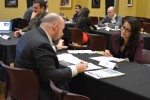
The Annual Student Pipeline Industry Roundtable Event (ASPIRE) was held on Thursday, March 16, 2017 at Northeastern University, Boston. Each year, ASPIRE, which is hosted by ALERT (Awareness and Localization of Explosives-Related Threats) and Gordon-CenSSIS (The Bernard M. Gordon Center for Subsurface Sensing and Imaging Systems), brings together members of the academic, industrial, and government communities to engage in dialogue, and provides networking opportunities for ALERT and Gordon-CenSSIS students looking for internships, co-op opportunities, and employment.
Participants at ASPIRE 2017 included industry representatives from American Science and Engineering/Rapiscan Systems, Analog Devices, Hamamatsu Photonics, HXI, and Morpho Detection; government representatives from the Department of Homeland Security, U.S. Coast Guard, U.S. Customs and Border Protection, and the Transportation Security Laboratory (TSL); and ALERT-affiliated graduate students from Boston University, Duke University, Northeastern University, Purdue University, Texas Tech University, and University of Puerto Rico Mayagüez.
The event started off in the early afternoon with welcoming remarks from Dr. Carey Rappaport (ALERT Deputy Director, ALERT Research Thrust Leader for R3 Bulk Sensors and Sensor Systems, and Electrical and Computer Engineering professor at Northeastern University), followed by industry and government introductions delivered by Emel Bulat (ALERT Senior Consultant for Corporate and Government Partnerships). Afterward, industry and government members gave 8-minute presentations on their organizations, research needs, and job openings. In the late afternoon, Dr. Hanumant Singh (Electrical and Computer Engineering, and Mechanical and Industrial Engineering professor at Northeastern University) delivered the keynote talk: “Autonomous Surface Vessels: High Resolution Mapping for Change Detection Spatially and Temporally.” This was followed by two separate roundtable networking sessions, in which representatives from industry and government met one-on-one with students, as well as with each other.
On the morning of the event, ALERT was pleased to welcome Brian Dolph of the U.S. Coast Guard and Chris Mocella of U.S. Customs and Border Protection to the laboratories of ALERT researchers, Dr. Octavia Camps, Dr. Jose-Martinez-Lorenzo, Dr. Carey Rappaport, and Dr. Matteo Rinaldi in order to showcase their research and its relevance to the Homeland Security Enterprise.
Faculty Spotlight: Joel Greenberg March 31, 2017
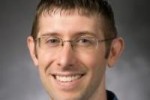
Dr. Joel Greenberg, an Assistant Research Professor in the Department of Electrical and Computer Engineering at Duke University, is one of the newest ALERT researchers. He is leading Project R1-C.3, “Characterizing, Modeling, and Mitigating Texturing in X-Ray Diffraction Tomography,” a newly funded research project that kicked off in January, 2017. His research lab is made up of one Ph.D. student, two master’s students, and two undergraduates.
Dr. Greenberg’s background is in multiple fields, as he received his bachelor’s degree in Mechanical and Aerospace Engineering along with a certificate in Physics at Princeton University in 2005. He then received his A.M. and Ph.D. in Physics, as well as a graduate certificate in Photonics, from Duke University in 2012. When asked how he became interested in homeland security related research, he states, “After my Ph.D., I was the technical and project manager for the DHS Science and Technology Coded Aperture X-ray Imaging (CAXI) program, which was tasked with studying how new advances in hardware and software, and algorithms could impact and improve the detection of contraband in luggage. Since that time, I have had the privilege of becoming even more involved in the world of security-related technology development, which contains a fascinating intersection of academia, government, and industry.”
Concerning major research questions in the field, Dr. Greenberg is very interested in addressing the limits of X-ray based explosives sensing. He is passionate about responding to real-world problems, and states that, “Because there is a cost and benefit to every measurement made, performing sensing in an optimal way requires an understanding of the underlying physics, available technologies, and algorithmic approaches. Getting the most useful information out of a set of measurements is key in the current data-deluged world of today.”
Dr. Greenberg is involved in numerous projects beyond his work with ALERT. His work with the Department of Homeland Security involves research testing next-generation X-ray diffraction tomography scanners and information theoretic analyses of X-ray-based detection systems. He is also working with radiologists and physicians at Duke University to develop devices based on X-ray diffraction that can aid in cancer detection research.
ALERT Research Highlights March 31, 2017
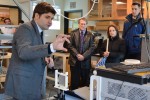
March 31, 2017
ALERT Thrust R3 Project Investigators, Dr. Carey Rappaport and Dr. Jose Martinez-Lorenzo of Northeastern University were awarded a patent for “Signal Processing Methods and Systems for Explosives Detection and Identification Using Electromagnetic Radiation” (U.S. Patent 9,575,045) on February 21, 2017. This patent is for an algorithm designed to rule out non-explosive concealed foreign objects concealed under clothing and affixed to the skin, reducing the number of false alarms, and thus, the number of pat-downs needed, leading to greater accuracy in threat detection and shorter security lines. The improved reliability would benefit many: passengers, airlines, and the Transportation Security Administration; and possibly lead to the expansion of AIT Millimeter Wave Scanners into everyday use, such as railway stations, sporting venues, and other soft targets. Read more about their research here.
Dr. Rappaport was recently selected by the IEEE Antennas and Propagation Society (AP-S) as a Distinguished Lecturer for 2017-2019. The IEEE AP-S Distinguished Lecturer Program sends experts, the Distinguished Lecturers, to visit active AP-S Chapters around the world and give talks on topics of interest and importance to the Antennas and Propagation community. Read more here.
Dr. Martinez-Lorenzo was recently awarded a $500K National Science Foundation (NSF) CAREER Award for his work on developing a method for “4D mm-Wave Compressive Sensing and Imaging at One Thousand Volumetric Frames per Second.” Millimeter-wave sensing and imaging systems are generally used for a wide range of applications, such as security monitoring to detect potential threats at the airport and biological imaging for wound diagnosis and healing. Because this is the first four-dimensional millimeter-wave imaging system that can operate in quick-changing scenarios, it will benefit society greatly. Read more about how Dr. Martinez plans to use this award here.
ALERT Thrust R2 Project Investigator, Dr. Steve Beaudoin of Purdue University was recently awarded “Best Presentation” in his session for a paper he presented on at the Annual AlChE Meeting in November 2016. The paper was based on his research project that was recently selected as a new ALERT project. The new project, titled “A Novel Method for Evaluating the Adhesion of Explosives Residue,” aims to provide insight into the reasons why explosives residues stick to surfaces and what must be done to effectively detect those residues in air transportation security environments. Read more about Dr. Beaudoin’s research here.
Professor Rappaport Selected as an IEEE Antennas and Propagation Society Distinguished Lecturer for 2017-2019 February 21, 2017

ALERT Deputy Director and Electrical and Computer Engineering professor, Carey Rappaport of Northeastern University was selected by the IEEE Antennas and Propagation Society (AP-S) as a Distinguished Lecturer for 2017-2019. The IEEE AP-S Distinguished Lecturer Program sends experts, the Distinguished Lecturers, to visit active AP-S Chapters around the world and give talks on topics of interest and importance to the Antennas and Propagation community.
Professor Rappaport has been a Northeastern University faculty member since 1987, and has been teaching Electrical and Computer Engineering since July 2000. In 2011, he was appointed as a College of Engineering Distinguished Professor. Professor Rappaport has written over 400 technical journal articles and conference papers on various topics, including electromagnetic wave propagation and scattering computation, microwave antenna design, and bioelectromagnetics. He has also received two reflector antenna patents, two biomedical device patents, and four subsurface sensing device patents.
Professor Rappaport’s Distinguished Lecture topics include:
- “A High Gain Toroidal Reflector Antenna for Multistatic 3-D Whole Body Millimeter-Wave Imaging”
- “Multifocal Bootlace Lens Design Concepts”
- “Modeling Frequency Dependent Biological Tissue for FDTD Analysis Using a Single Pole Z-Transform Conductivity Model”
- “Localizing Tunnel Positions Under Rough Surfaces with Underground Focused Synthetic Aperture Radar”
- “Modeling Standoff Radar Scattering of Concealed Body-Worn Objects for Suicide Bomber Detection”
- “Electromagnetic Sensing and Treatment of Living Things: Using Microwaves to Detect and Treat Disease in Humans and Trees”
- “Advanced Concepts for Ground Penetrating Radar Detection of Land Mines.”
Congratulations to Professor Rappaport on being selected as an IEEE Antennas and Propagation Society Distinguished Lecturer for 2017-2019!
2016-2017 Kurlat Scholarship Awarded January 27, 2017
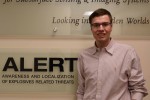
ALERT student, Anthony Bisulco of Northeastern University is the 2016-2017 recipient of The Saul and Gitta Kurlat Undergraduate Engineering Scholarship. This is the second year in a row that Anthony was selected for this award based on his academic excellence and strong dedication to the research he engages in with ALERT researcher, Dr. Jose Martinez. Anthony is a 3rd year undergraduate pursuing the BS in Electrical and Computer Engineering. In addition to conducting ALERT research, Anthony also serves on the ALERT Student Leadership Council.
Established in 2004, this scholarship is made possible through the generous donation of Saul Kurlat (M.S. Engineering Management, Northeastern University, Class of 1962) and his wife, Gitta Kurlat. Their endowment for a renewable scholarship award is used to support a deserving undergraduate engineering student who is actively involved in research with the Bernard M. Gordon Center for Subsurface Sensing and Imaging Systems (Gordon-CenSSIS) at Northeastern University.
ALERT Researcher Named IAPR Fellow January 27, 2017

Professor Yun Raymond Fu, ALERT researcher and interdisciplinary faculty member affiliated with the College of Engineering and the College of Computer and Information Science at Northeastern University, has been selected as a fellow of the International Association for Pattern Recognition (IAPR). Fellows are elected to the IAPR every two years as an acknowledgment of distinguished contributions in the field of pattern recognition and to the organization’s activities.
Professor Fu was selected to be a fellow for his contributions to pattern recognition, data mining and visual intelligence. Professor Fu’s research interests include machine learning and computational intelligence, social media analytics, human-computer interaction, and cyber-physical systems. He is the founding director of the Synergistic Media Learning Lab.
Additionally, Professor Fu contributes to Video Be on the Lookout (vBOLO), a project led by ALERT and VACCINE (Visual Analytics for Command, Control, and Interoperability Environments), both DHS Centers of Excellence, in conjunction with the Greater Cleveland Regional Transit Authority (GCRTA). vBOLO applies cutting-edge research in human re-identification using subjects’ clothing, gait, and faces to produce an entirely computerized system that could interface directly with a video surveillance network to automatically find re-appearances of tagged suspects. The potential impact of large-scale re-identification systems in major transit hubs and other crowded venues includes reductions in thefts, real-time or forensic tracking of suspects’ destinations or origins in surveillance video, and assessments of intervention strategies on flow rates and system efficiency.
ALERT congratulates Professor Fu on his IAPR fellowship!
Spring 2017 ASPIRE Announced January 27, 2017
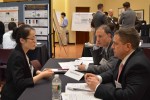
Every year ALERT and Gordon-CenSSIS host the Annual Student Pipeline Industry Roundtable Event (ASPIRE) aimed at building connections between students and ALERT industrial collaborators. The upcoming ASPIRE will be held on Thursday, March 16, 2017 at Northeastern University and will feature presentations by industry members, a poster session by students, and a “speed-dating” session for students and industry members to have one-on-one time to discuss their common goals.
The previous ASPIRE (held in Spring 2016) was attended by students from ALERT’s academic partner institutions, as well as representatives from the following ALERT industrial collaborators: American Science & Engineering, Analog Devices Inc., HXI LLC, Morpho Detection, Passport Systems Inc., Rapiscan Systems, and Raytheon Company; as well as representatives from two government agencies, the Transportation Security Laboratory (TSL) and the Department of Homeland Security (DHS).
ASPIRE continues to give students the opportunity to present their research and career aspirations to industry members looking to recruit for internships and full-time positions. ASPIRE also offers participants a unique format in which to cover a broad range of topics significant to the Homeland Security Enterprise, and provides students and industry members with meaningful and effective networking opportunities.
This event is by invitation only for our ALERT and Gordon-CenSSIS industry members and students. More details and an agenda are forthcoming.
Photo caption: Yongfang Cheng, Northeastern University PhD candidate meeting with Piero Landolfi and Kurt Bistany of Morpho Detection at the 2016 ASPIRE.

